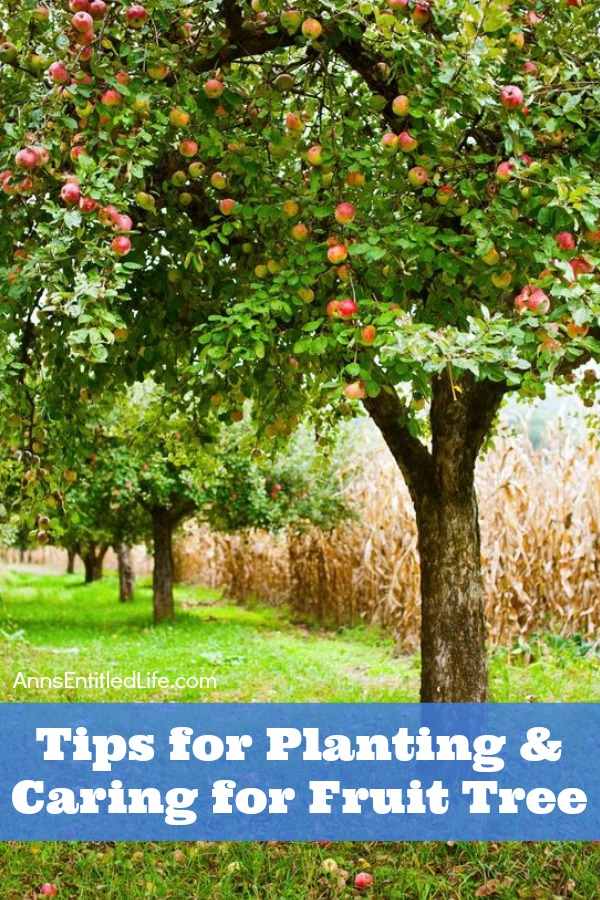Everyone loves fresh fruit, especially if it is grown in your own backyard. But planting and caring for fruit trees requires some care; from planting to harvest. If your fruit trees are not cared for correctly then you risk the tree becoming diseased or not producing. Fortunately, a good planting foundation goes a long way toward a long, fruitful future harvest.
Tips for Planting and Caring for Fruit Trees
Hubby’s hunting land currently has pear and apple trees. No one has sprayed since the dawn of time, so these are technically organic trees… and the fruit looks like it. We are considering planting more trees, and/or spraying the trees that are currently there, although, with the big bucks organic fruit costs, it is a tough call. Hubby’s hunting land is across the street from the Lake Ontario shoreline (literally), so it makes for an excellent apple and pear growing climate (the area around the Great Lakes in New York State is actually a micro-climate much warmer than the area 50 or 100 miles away from the shoreline). More trees in this apple-rich area are something we are seriously considering.
Here are some tips for planting and caring for fruit trees.
Planting Fruit Trees
Fruit trees generally like to be in direct sunlight. When choosing a spot to plant your tree make sure it is a spot that receives full sun. They also need soil that is well-drained. There are a few fruit trees that can handle conditions that are not ideal but it is generally considered good practice to always have well-drained soil. If you are concerned about the quality of soil that you can offer your tree, opt for a raised planting bed.
When purchasing a bare-root tree during the off-season, be sure to plant it as soon as possible. Soak bare roots in a bucket of water for several hours before plating. You could also plant it in a container before growing season arrives. The National Gardening Association offers good planting information, so click here. Generally speaking, north zone 7 gets planted in the fall, south of it gets planted in the spring. Not sue of your zone plant dates? click here. To find your planting zone, click here.
If purchasing a fruit tree with a developed root ball, first measure the root ball so you know the size of the hole you must dig. Make certain to dig the planting hole so the root collar of the fruit tree will be several inches above the hole, and dig at least two times wider than your root ball. Dig your hole so the sides slope. Cut the string and wire from around the trunk of the tree. After placing the tree in the hole, as well as the burlap.
Caring For Fruit Trees
After you have planted your tree it is important to keep it watered whenever the top two inches of the soil are dry. After the tree develops deeper root systems you won’t need to water as often. In order to produce an extra juicy crop, it’s necessary to provide a deep watering every so often.
The best time to high-fertilize fruit trees is during the growing season, starting in early spring when budding begins, and ending in July. You do not want to fertilize too late in the season because when buds are pushed too late in the season the tree can be more susceptible to winter injury.
When fertilizing your tree be sure to go off of the growth of the tree. If you notice it has subpar growth you will want to fertilize with a high-nitrogen fertilizer in the beginning of spring.
If you notice that the tree seems to be stagnant no matter how much you fertilize, there may be a problem with the soil you’ve planted it in. You can have the soil professionally tested and get recommendations from a local nursery if this happens.
Planting and caring for fruit trees can be extremely rewarding. Adding a couple of fruit trees to your already thriving garden will add a sweet touch of produce that you can enjoy along with the other fruits of your labor. And remember, fruit trees are beneficial to the honey bee population!
Do you have a fruit tree in your garden? Are there any tips that you would have included?
Sources
● US Forestry Department
● National Gardening Association
● USDA
● Click here for more How Does Your Garden Grow Topics on Ann’s Entitled Life.
● Enjoy this post? Sign up for the Ann’s Entitled Life FREE Weekly Newsletter to stay connected.

Taneesha Alwani says
yes i have a lemon tree in my garden & it gives lots of fruits but as the new leaves are appearing on it mealybugs are also there so how to get rid of that?